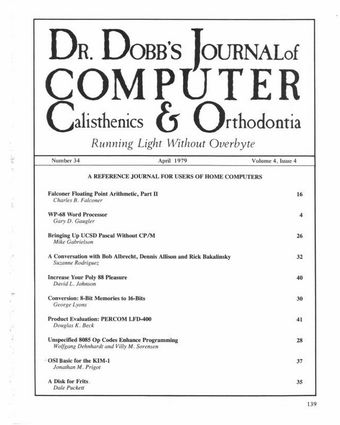
[author : Gary D. Gaugler] #Listing #Assembly
Extract : « Normally we typeset articles, but we reproduce this here the way we received it so you can get an idea of what the program does. [...]
THE WP68 WORD PROCESSOR IS A POWERFUL ADDITION TO THE SMOKE SIGNAL BFD-68 DISK SYSTEM, WP68 PROCESSES FILES WHICH ARE READ FROM THE DISK. THE FILES ARE CREATED BY USING THE SSB SUPER EDITOR OR OTHER MEANS TO PRODUCE A FILE CONTAINING TEXT AND SPECIAL COMMANDS WHICH AWE PROCESSED BY THE WORD PROCESSOR. [...] »
[author : Charles B. Falconer] #Listing #Assembly #Mathematics #Programming
Extract : « Herewith Falconer Floating Point Arithmetic II-the concluding chapter-which we continue from last issue. [...] »
[author : Mike Gabrielson] #Listing #Assembly #Pascal #Programming
Extract : « Even if you don’t have CP/M or a CP/M compatible system, you can transport UCSD 8080 PASCAL to your machine by using XTRACT, a program for extracting files from UCSD floppies: [...] »
[author : Wolfgang Dehnhardt and Villy M. Sorenson] #Assembly #Programming
Extract : « Ten operating codes and two flag bits previously unknown to most users of the 8085 microprocessor will enable programmers to write more efficient routines. The new members of the instruction set, which were stumbled upon during the testing of an assembler-disassembler module, include seven op codes that involve the processing of register pairs, two that involve jump operations with one new flag bit, and one that performs a conditional restart on the overflow indication of the other flag bit [...] »
[author : George Lyons] #Encoding
Extract : « To use 16-bit size processors such as the TI9900 and the new generation of chips including the Intel 8086, Z8000 etc., in the S-100 bus, the proposed S-100 bus standards from the IEEE suggest combining the original 8-bit DATA IN and DATA OUT S-100 lines into a single bi-directional 16-bit wide data bus.
Within the same computer system, the same lines could also be used in the original, split eight bit mode, as long as only one kind of transfer were attempted at one time.
John Walker of Marinchip Systems describes a similar bi-directional system in the January, 1979 Byte, and his company actually supplies a TI9900 cpu card implementing that system on the S-100 bus, the first product of its kind. [...] »
[author : Dale Puckett] #Listing #Assembly #Storage
Extract : « I am sending you some software I know your 6800 fans will be glad to have. Enclosed you will find disk drivers which work with Frits Van Der Wateren’s LISP for the 6800 (DDJ #28). They run in FLEX. They could however, be easily modified to run in any disc operating system. I could supply the object on source to anyone who sent a disc with return postage. [...] »
[author : Jonathan M. Prigot] #Listing #Assembly #BASIC #Programming
Extract : « For some time, now, if a KIM-1 user wished to run Microsoft’s 8K BASIC on their system, they had their choice of two cassettes. Unfortunately, since both versions seem to use self-modifying code, if the KIM crashes, then the tape must be reloaded. Putting it into ROM would prevent this, but, of course, this cannot be done. [...] »
[author : David L. Johnson] #BASIC #Programming
Extract : « Tired of interrupting your train of thought to stop and load yet another short program? Combine those programs into one big one. [...] »
[author : Douglas K. Beck] #Storage #Review
Extract : « Z80/S100/CP-M folk have it rather simple. All the choices have been made for them with respect to hardware and operating systems. Nonconformists have a little more trouble. For instance, the SWTP-6800 has at least three disc drive/operating system combinations available. To weigh the potential and capabilities of any of them is difficult at best. After living with my SWTP-6800 for a year it became obvious that the operating system and supporting hardware would have to be expanded far beyond the original cassette-based equipment.
My major concern was to provide myself with more time to work on projects. Software support and a modular approach to system configuration also received strong consideration. The time element came from the fact that tape entry with a binary format could not bring the load time for BASIC or the Assembler below four minutes. [...] »